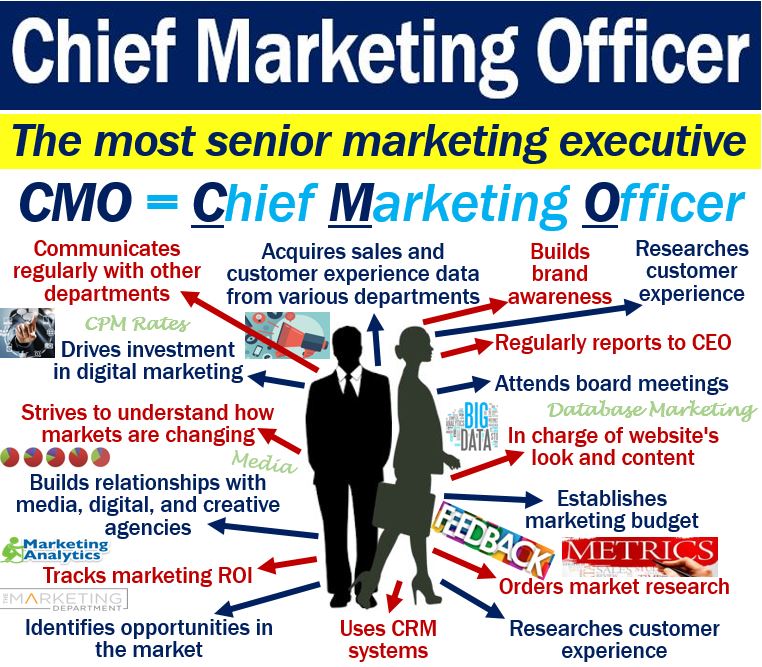A chief marketing officer (CMO) is an executive who is in charge of developing and overseeing marketing and advertising plans. The CMO reports to the CEO and is part of the C-level executive team.
Many companies use the term Marketing Director with the same meaning as CMO. However, some management and marketing experts stress that a CMO has a wider role than a marketing director.
The chief marketing officer has to collaborate and keep pace with the other c-executives (‘c’ = ‘chief’). This is vital if the company is to adapt in today’s rapidly-shifting market.
The chief marketing officer is in charge of developing marketing plans to increase sales and growth.
CMOs also create strategies to promote brand recognition and give the company a competitive advantage.
Product development and distribution chain management are important elements of a CMO’s focus.
CampaignLive.co.uk has the following job description for CMOs:
“Chief marketing officers are responsible for not only their organization’s marketing strategy but also product development, customer service, branding, pricing and sales management.”
If a company combines all its goals and objectives into one plan, it has a marketing strategy.

Chief marketing officer – main role
The main role of a chief marketing officer is to supervise the company’s position and image in the marketplace. In this context, the term ‘marketplace’ means ‘market’ in the abstract sense, i.e., the business environment.
The CMO also determines future market approaches, customer outreach, and manages public relations (PR).
In some companies, however, public relations is a separate department. In such cases, the chief marketing officer liaises closely with the PR department.
Today, the CMO’s position is much more important than it used to be. Marketing experts say that this is due to advances in technology and communications.
We can now reach customers via their smartphones, social media, AI, and the Internet. AI stands for artificial intelligence.
Candidate for CMO position
Companies with a vacant CMO position will only interview candidates with experience. Specifically, at least ten years’ marketing and advertising experience.
Ideally, the job applicant should have even more years of experience in management positions.
A degree in marketing and in some cases an MBA is desirable. In fact, it is often a requisite. In other words, if you don’t have an MBA, you probably won’t even get an interview.
MBA stands for Master of Business Administration. In some UK colleges, the abbreviation stands for Masters in Business Administration. It is a post-graduate degree.
The candidate should also have excellent leadership and communication skills, as well as project development experience.
Chief marketing officer – C-level executives
C-level executives are top employees whose abbreviated positions start with the letter ‘C,’ which stands for ‘chief.’
A CEO, i.e., Chief Executive Officer, for example, is the highest-ranking c-executive.
COO stands for Chief Operating Officer, while the letters CFO stand for Chief Financial Officer.
The CTO or Chief Technology Officer is in charge of making sure the company has all the technology it needs.
The CHRO, the Chief Human Resources Officer, is the top executive in charge of human resources.
CIO has two possible meanings:
– In some companies, the officer in charge of investments is the CIO, i.e., Chief Investment Officer.
– The top executive in charge of information technology management is the CIO or Chief Information Officer.
